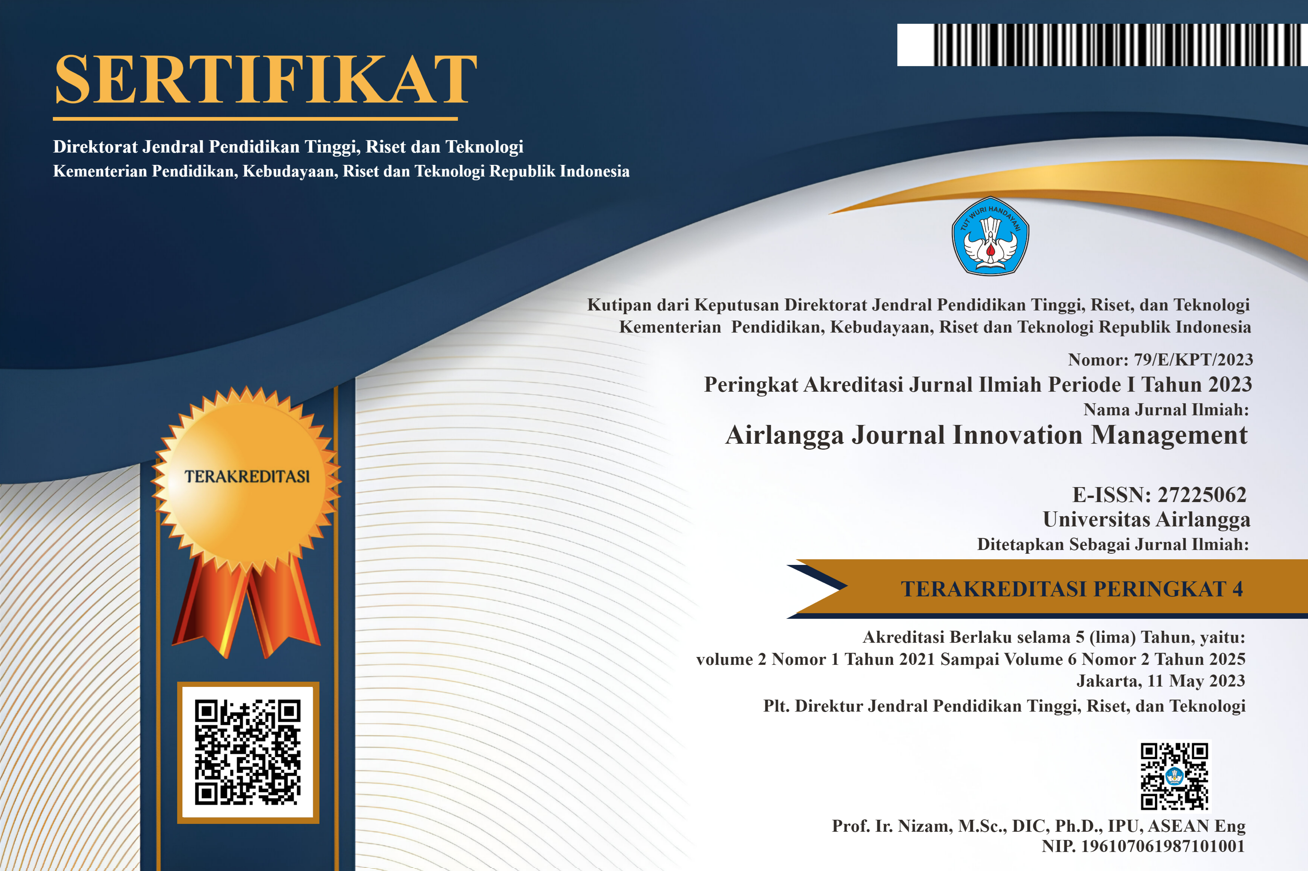MODERATING EFFECT OF MANAGERIAL AND PROFSSIONAL ASSISTANCE ON INNOVATION STRATEGY AND ACADEMIC SPIN-OFF MANAGEMENT
Downloads
The university is required to commercialize the results of research and knowledge of the university through academic spin-off. Academic spin-off benefit for stimulating the economy, creating job growth and innovation. However, academic spin-off find difficulty in offering products and services to the market because of the lack of knowledge related to managerial and resource management. Means commonly used to overcome this obstacle is to establish a business incubator in the form of a centralized facility that provides access, support and university policy. Business Incubator helps new academic spin-off stand to better understand the market and to provide guidance in the initial phase of the establishment of academic spin-off. This study aimed to examine the moderating effect of the assistance provided university business incubator in the election strategy of innovation and academic spin-off performance. The study was conducted at 76 academic spin-off in Yogyakarta and Semarang. In this study developed a theoretical model by proposing three hypotheses to be tested using regression analysis. The survey results revealed that academic spin-off conduct exploitation strategy proved a positive influence on the performance of academic spin-off. Instead, academic spin-off conduct proven exploration strategy negatively affect academicspin-off performance. Furthermore, managerial and professional assistance as moderating variables are proven to be able to strengthen the relationship between innovation strategy and academic spin-off performance.
Keywords:Academic Spin-off , Managerial and Professional Assistance, Academic Spin-offPerformance
Baron, R. M., & Kenny, D. A. (1986). The moderator–mediator variable distinction in social psychological research: Conceptual, strategic and statistical considerations. Journal of Personality and Social Psychology, 51, 1173– 1182.
Bergek, A., & Norrman, C. (2008). Incubator best practice: A framework. Technovation, 28(1-2), 20-28.
Bruneel, J., Ratinho, T., Clarysse, B., & Groen, A. (2012). The Evolution of Business Incubators: Comparing demand and supply of business incubation services across different incubator generations. Technovation, 32(2), 110-121.
Callan, J., & Connell, M. (2001). Query-based sampling of text databases. ACM Transactions on Information Systems (TOIS), 19(2), 97-130.
Cao, Q., Gedajlovic, E., Zhang, H., 2009. Unpacking organizational ambidexterity: dimensions, contingencies, and synergistic effects. Organ. Sci. 20 (4), 781– 796.
Christensen, C. M., & Bower, J. L. (1996). Customer power, strategic investment, and the failure of leading firms. Strategic management journal, 17(3), 197- 218.
Cooper, D. R., & Schindler, P. S. (2014). Business Research Methods. Data Preparation and Description.
Fini, R., Grimaldi, R., Santoni, S., & Sobrero, M. (2011). Complements or substitutes? The role of universities and local context in supporting the creation of academic spin-offs. Research Policy, 40(8), 1113-1127.
Grimaldi, R., & Grandi, A. (2005). Business incubators and new venture creation: an assessment of incubating models. Technovation, 25(2), 111-121.
Hackett, S. M., & Dilts, D. M. (2004). A systematic review of business incubation research. The Journal of Technology Transfer, 29(1), 55-82.
Hair, J. F. J., Black, W. C., Babin, B. J., & Anderson, R. E. (2014). Multivariate Data Analysis. Seventh Edition Prentice Hall.
Hitt, M. A., Ireland, R. D., Sirmon, D. G., & Trahms, C. A. (2011). Strategic entrepreneurship: creating value for individuals, organizations, and society. Academy of management perspectives, 25(2), 57-75.
Levinthal, D. A., & March, J. G. (1993). The myopia of learning. Strategic management journal, 14(S2), 95-112.
Lockett, A., Siegel, D., Wright, M., & Ensley, M. D. (2005). The creation of spin- off firms at public research institutions: Managerial and policy implications. Research policy, 34(7), 981-993.
Löfsten, H., & Lindelöf, P. (2005). R&D networks and product innovation patterns”academic and non-academic new technology-based firms on Science Parks. Technovation, 25(9), 1025-1037.
March, J. G. (1991). Exploration and exploitation in organizational learning.Organization science, 2(1), 71-87.
Nonaka, I. & Takeuchi, H., (1995). The Knowledge-Creating Company: How Japanese Companies Create the Dynamics of Inovation. New York: Oxford University Press.
Phan, P. H., Siegel, D. S., & Wright, M. (2005). Science parks and incubators: observations, synthesis and future research. Journal of business venturing, 20(2), 165-182.
Slater, S. F., Mohr, J. J., & Sengupta, S. (2014). Radical product innovation capability: Literature review, synthesis, and illustrative research propositions. Journal of Product Innovation Management, 31(3), 552-566.
Soetanto, D., & Jack, S. (2016). The impact of university-based incubation support on the innovation strategy of academic spin-offs. Technovation, 50, 25-40.
Soetanto, D., & van Geenhuizen, M. (2019). Life after incubation: The impact of entrepreneurial universities on the long-term performance of their spin-offs. Technological Forecasting and Social Change, 141, 263-276.
Vanaelst, I., Clarysse, B., Wright, M., Lockett, A., Moray, N., & S'Jegers, R. (2006). Entrepreneurial team development in academic spinouts: An examination of team heterogeneity. Entrepreneurship Theory and Practice, 30(2), 249-271.
Voss, G. B., & Voss, Z. G. (2013). Strategic ambidexterity in small and medium- sized enterprises: Implementing exploration and exploitation in product and market domains. Organization Science, 24(5), 1459-1477.
Yalcinkaya, G., Calantone, R. J., & Griffith, D. A. (2007). An examination of exploration and exploitation capabilities: Implications for product innovation and market performance. Journal of International Marketing, 15(4), 63-9
- The journal allows authors to hold copyright without restrictions and retain publication rights without restrictions. The author retains the copyright and grants the first publication rights to the journal, with his work simultaneously licensed under the Creative Commons Attribution-NonCommercial-ShareAlike 4.0 International License (CC BY-NC-SA). This license allows others to share the work with acknowledgment of authorship and initial publication in this journal, provided that the work is not used for commercial purposes and that any derivative works must use the same license.
- Authors may enter into additional contractual agreements for non-exclusive distribution of the journal publication version (e.g., uploading it to an institutional repository or publishing it in book form), while still including acknowledgment of the initial publication in this journal.
- Authors are allowed and encouraged to upload their work online (e.g., in an institutional repository or personal website) before and during the submission process. This can support productive scientific exchanges as well as increase citations to published works.

AJIM by UNAIR is licensed under a Creative Commons Attribution-NonCommercial-ShareAlike 4.0 International License.





















